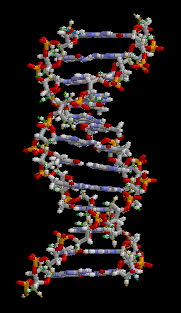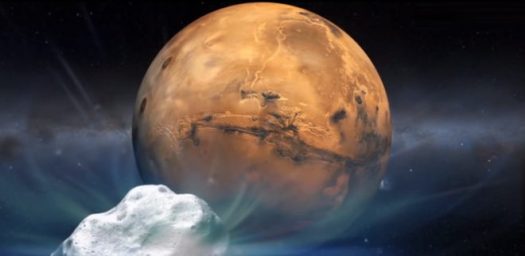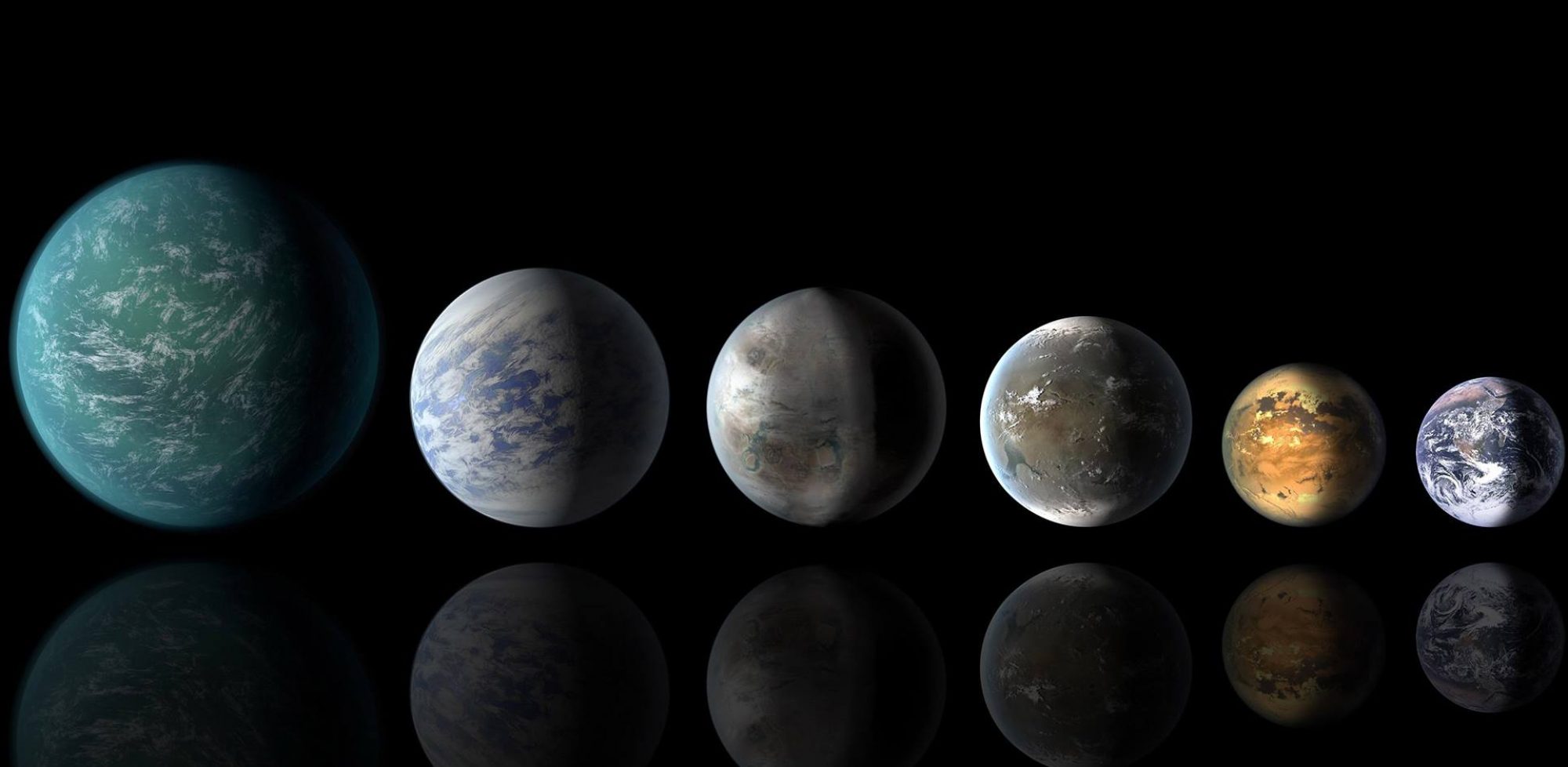Sometimes personal affairs intervene for all of us, and they have now for your Many Worlds writer and his elderly father. But rather than remain off the radar screen, I wanted to repost this column which has a new import.
It turns out that versions of the instrument described below — a miniature gene sequencing device produced by Oxford Nanopore — have been put forward as the kind of technology that could detect life in the plume of Enceladus, or perhaps on Europa or Titan.
Major figures in the astrobiology field, including Steve Benner of the Foundation for Applied Molecular Evolution (FfAME) and Chris McKay of NASA Ames Research Center see this kind of detection of the basic polymer backbone of RNA or DNA life as a potentially significant way forward. Three different “Icy Moon” teams are vying for a NASA New Frontiers mission to Enceladus and Titan, and this kind of technology plays a role in at least one of the proposed missions.

When scientists approach the question of how life began on Earth, or elsewhere, their efforts generally involve attempts to understand how non-biological molecules bonded, became increasingly complex, and eventually reached the point where they could replicate or could use sources of energy to make things happen. Ultimately, of course, life needed both.
Researchers have been working for some time to understand this very long and winding process, and some have sought to make synthetic life out of selected components and energy. Some startling progress has been made in both of these endeavors, but many unexplained mysteries remain at the heart of the processes. And nobody is expecting the origin of life on Earth (or elsewhere) to be fully understood anytime soon.
To further complicate the picture, the history of early Earth is one of extreme heat caused by meteorite bombardment and, most important, the enormous impact some 4.5 billion years of the Mars-sized planet that became our moon. As a result, many early Earth researchers think the planet was uninhabitable until about 4 billion years ago.
Yet some argue that signs of Earth life 3.8 billion years ago have been detected in the rock record, and lifeforms were certainly present 3.5 billion years ago. Considering the painfully slow pace of early evolution — the planet, after all, supported only single-cell life for several billion years before multicellular life emerged — some

researchers are skeptical about the likelihood of DNA-based life evolving in the relatively short window between when Earth became cool enough to support life and the earliest evidence of actual life.
So what else, from a scientific as opposed to a religious perspective, might have set into motion the process that made life out of non-life?
One long considered yet generally quickly dismissed answer is getting new attention and a little more respect. It invokes panspermia, the sharing of life via meteorites from one planet to another, or delivery by comet.
In this context, the question generally raised is whether Earth might have been seeded by early Martian life (if it existed). Mars, it is becoming increasingly accepted, was probably more habitable in its early period than Earth. But panspermia inherently could go the other way as well, or possibly even between solar systems.
A team of prominent scientists at MIT and Harvard are sufficiently convinced in the plausibility of panspermia that they have spent a decade, and a fair amount of NASA and other funding, to design and produce an instrument that can be sent to Mars and potentially detect DNA or more primitive RNA.
In other words, life not only similar to that on Earth, but actually delivered long ago from Earth. It’s called the The Search for Extraterrestrial Genomes, or SETG.
Gary Ruvkun is one of those researchers, a pioneering molecular biologist at Massachusetts General Hospital and professor of genetics at Harvard Medical School.
I heard him speaking recently at a Space Sciences Board workshop on biosignatures, where he described the real (if slim) possibility that DNA or RNA-based life exists now on Mars, and the instrument that the SETG group is developing to detect it should it be there.

The logic of panspermia — or perhaps “dispermia” if between but two planets — is pretty straight-forward, though with some significant question marks. Both Earth and Mars, it is well known, were pummeled by incoming meteorites in their earlier epochs, and those impacts are known to have sufficient force to send rock from the crash site into orbit.
Mars meteorites have been found on Earth, and Earth meteorites no doubt have landed on Mars. Ruvkun said that recent work on the capacity of dormant microbes to survive the long, frigid and irradiated trip from planet to planet has been increasingly supportive.
“Earth is filled with life in every nook and cranny, and that life is wildly diverse,” he told the workshop. “So if you’re looking for life on Mars, surely the first thing to look for is life like we find on Earth. Frankly, it would be kind of stupid not to.”

The instrument being developed by the group, which is led by Ruvkun and Maria Zuber, MIT vice president for research and head of the Department of Earth, Atmospheric and Planetary Sciences. It would potentially be part of a lander or rover science package and would search DNA or RNA, using techniques based on the exploding knowledge of earthly genomics.
The job is made easier, Ruvkun said, by the fact that the basic structure of DNA is the same throughout biology. What’s more, he said, there about 400 specific genes sequences “that make up the core of biology — they’re found in everything from extremeophiles and bacteria to worms and humans.”
Those ubiquitous gene sequences, he said, were present more than 3 billion years ago in seemingly primitive lifeforms that were, in fact, not primitive at all. Rather, they had perfected some genetic pathways that were so good that they still used by most everything alive today.
And how was it that these sophisticated life processes emerged not all that long (in astronomical or geological terms) after Earth cooled enough to be habitable? “Either life developed here super-fast or it came full-on as DNA life from afar,” Ruvkun said. It’s pretty clear which option he supports.
Ruvkun said that the rest of the SETG team sees that kind of inter-planetary transfer — to Mars and from Mars — as entirely plausible, and that he takes panspermia a step forward. He thinks it’s possible, though certainly not likely nor remotely provable today, that life has been around in the cosmos for as long as 10 billion years, jumping from one solar system and planet to another. Not likely, but at idea worth entertaining.

Maria Zuber of MIT, who was the PI for the recent NASA GRAIL mission to the moon, has been part of the SETG team since near its inception, and MIT research scientist Christopher Carr is the project manager. Zuber said it was a rather low-profile effort at the start, but over the years has attracted many students and has won NASA funding three times including the currently running Maturation of Instruments for Solar System Exploration (MatISSE) grant.
“I have made my career out of doing simple experiments. if want to look for life beyond earth helps to know what you’re looking for.
“We happen to know what life on Earth is like– DNA based or possibly RNA-based as Gary is looking for as well. The point is that we know what to look for. There are so many possibilities of what life beyond Earth could be like that we might as well test the hypothesis that it, also, is DNA based. It’s a low probability result, but potentially very high value.”
DNA sequencing instruments like the one her team is developing are taken to the field regularly by thousands of researchers, including some working with with SETG. The technology has advanced so quickly that they can pick up a sample in a marsh or desert or any extreme locale and on the spot determine what DNA is present. That’s quite a change from the pain-staking sequencing done painstakingly by graduate students not that long ago.
Panspermia, Zuber acknowledged, is a rather improbable idea. But when nature is concerned, she said “I’m reticent to say anything is impossible. After all, the universe is made up of the same elements as those on Earth, and so there’s a basic commonality.”
Zuber said the instrument was not ready to compete for a spot on the 2020 mission to Mars, but she expects to have a sufficiently developed one ready to compete for a spot on the next Mars mission. Or perhaps on missions to Europa or the plumes of Enceladus.

The possibility of life skipping from planet to planet clearly fascinates both scientists and the public. You may recall the excitement in the mid 1990s over the Martian meteorite ALH84001, which NASA researchers concluded contained remnants of Martian life. (That claim has since been largely refuted.)
Of the roughly 61,000 meteorites found on Earth, only 134 were deemed to be Martian as of two years ago. But how many have sunk into oceans or lakes, or been lost in the omnipresence of life on Earth? Not surprisingly, the two spots that have yielded the most meteorites from Mars are Antarctica and the deserts of north Africa.
And when thinking of panspermia, it’s worthwhile to consider the enormous amount of money and time put into keeping Earthly microbes from inadvertently hitching a ride to Mars or other planets and moons as part of a NASA mission.
The NASA office of planetary protection has the goal of ensuring, as much as possible, that other celestial bodies don’t get contaminated with our biology. Inherent in that concern is the conclusion that our microbes could survive in deep space, could survive the scalding entry to another planet, and could possibly survive on the planet’s surface today. In other words, that panspermia (or dispermia) is in some circumstances possible.
Testing whether a spacecraft has brought Earth life to Mars is actually another role that the SETG instrument could play. If a sample tested on Mars comes back with a DNA signature result exactly like one on Earth–rather one that might have come initially from Earth and then evolved over billions of years– then scientists will know that particular bit of biology was indeed a stowaway from Earth.
Rather like how a very hardy microbe inside a meteorite might have possibly traveled long ago.

To argue the plausibility of panspermia, Zuber says”…After all, the universe is made up of the same elements as those on Earth, and so there’s a basic commonality.” but this is precisely an argument against panspermia. why should something not very likely on earth be more likely elsewhere? i would think that the heavy meteoritic bombardment required to launch life or dna on its interplanetary/interstellar journey points to just as narrow a time window elsewhere as on earth. so panspermia rather than solving the quick emergence problem would actually itself require a quick emergence of life.
LikeLike
Dear Mr. Kaufman, regarding your recent piece “In search of panspermia” Chandra Wickramasinghe, and Sir Fred Hoyle have worked on this issue for almost 40 years and written lots of referreed papers and books on the subject before most people could even spell ‘panspermia’ or had heard of it. They cite evidence for the existence of bacterial residues in interstellar space and propose that life on Earth began with the transport of live bacteria (and viral material) to Earth over the whole history of the Earth along with their bacterial DNA, of course, leading to the initiation of life on Earth. A summary of their findings and claims can be found here:
Click to access cosmicancestry.pdf
I am a retired professor of astronomy and physics and former chair of that department at Hanover College, a small liberal arts institution in southern Indiana. I taught an elective course called ‘Life In The Universe’ at the College for many years which drew amply from the work of Hoyle and Wickramasinghe, who for all intents and purposes, deserve most of the credit for reviving the theory of panspermia first proposed by Svante Arrhenius over a century ago.
I hope you like the article.
George Nickas
Corpus Christi, TX 78418
LikeLike